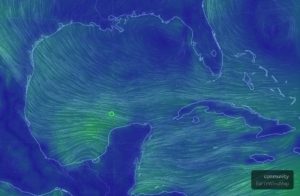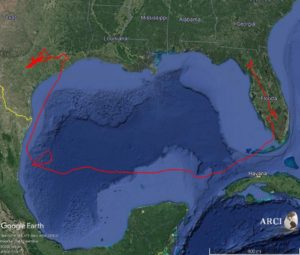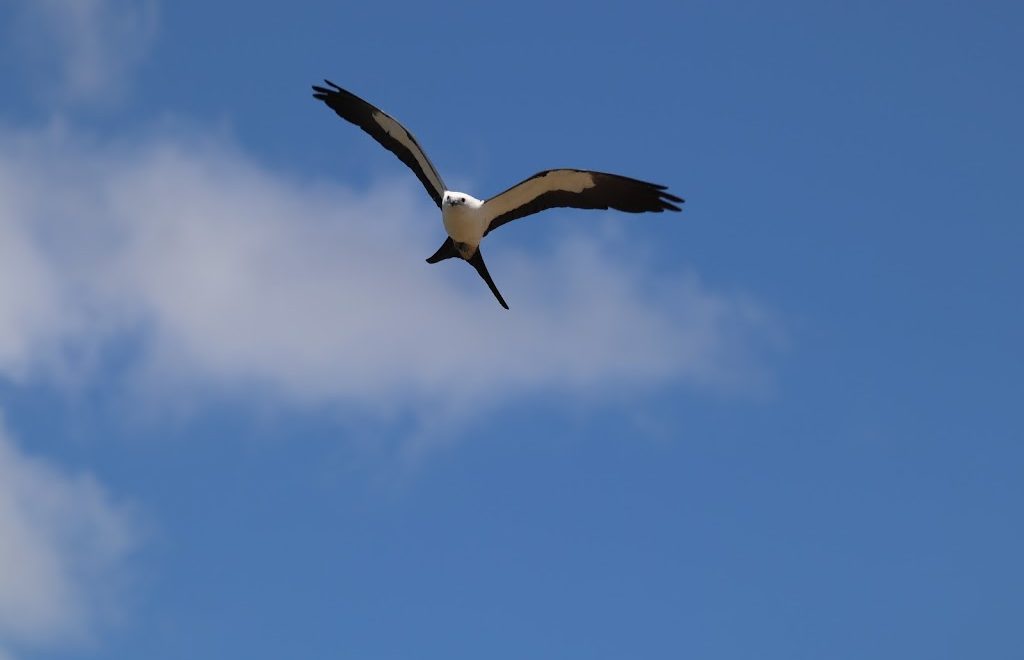Soon after we introduced you to Sanibel South in our last blog, she became the first of our tracked Swallow-tailed Kites to leave Florida for the winter. In fact, the start of her southbound migration has become one of the most exciting we have seen since our studies of Swallow-tailed Kite long-distance migration began in 1996.
As you may recall, Sanibel South started her southbound journey by first flying up to north-central Florida (Alachua and Gilchrist counties), where she joined daily foraging flocks of kites, which sometimes numbered in the hundreds, to feast on insects for a month. This strategy was soon to pay off as Sanibel South’s attempt to cross the Gulf of Mexico from southern Florida to the Yucatan Peninsula became one for the record books.
 |
| Swallow-tailed Kite foraging in Alachua County, Florida. Photo by Adam Kent |
Swallow-tailed kites are truly creatures of the wind. Typically, the eastern portion of the U. S. population, i.e., the ~65-70% that nest in Florida, Georgia, and South Carolina, prepares for southbound migration by moving into position in southern Florida, where they feed in flocks on flying insects by day and roost communally at night. As individuals achieve the body condition needed for their impending journey, they stage along the southwestern coast of Florida (seaward of Big Cypress Swamp and the Everglades) while awaiting favorable tailwinds that will help carry them across 450 to 600 miles of the Gulf of Mexico. As you can imagine, crossing such a vast expanse of open ocean is dangerous for any bird, but especially for a large soaring species that, like most raptors, relies mainly on upwardly rising thermals generated by heated land masses to stay aloft. Over-water wind direction and speed are critically important to migrating Swallow-tailed Kites because, unlike migrating songbirds and seabirds, they are not built to sustain self-powered flight for extended periods. To complicate matters further, weather patterns over the Gulf of Mexico are exceptionally volatile. A favorable wind on the tail of a kite heading out to sea can become a deadly headwind within a few hours or less, leaving a kite at the mercy of aerial currents that will keep places to rest, eat, or drink beyond their reach for several days.
 |
| Winds across the Gulf of Mexico. Maps by https://earth.nullschool.net/ |
From our long-term research, we know that, despite their astounding aeronautical prowess over the sun-soaked southern landscape, none of the Swallow-tailed Kites we have tracked survived over the Gulf of Mexico for more than 3 to 4 days and nights. Remember that the thermals that support the Swallow-tailed Kites’ endlessly energy-efficient soaring over land cannot be as frequent or powerful over the ocean. As we monitor the tagged kites during these dangerous times, seeing prolonged downwind flight far from shore followed abruptly by radio silence reminds us of the harsh consequences of the Swallow-tailed Kite’s physiological limits.
However, In the last few days, Sanibel South has miraculously raised the bar for those that will follow. After spending the night of July 24th in the Ten-thousand Islands National Wildlife Refuge (near Chokoloskee, Florida), she took a tailwind offshore around 10:00 a.m. and flew southwestward across the lower Florida Keys and out over the cold, deep waters of the Yucatan Channel for 260 miles, right toward the northeastern Yucatan Peninsula. With her speed and direct trajectory, it was not alarming to see her bypass Cuba. About half the kites we have tracked have done so, reaching the eastern shoreline of the Yucatan peninsula within 12 to 20 hours.
This time, though, as occasionally happens, the weather had a different plan. With 200 miles to go, a strong wind started blowing directly toward the west, and Sanibel South hitched a ride, blasting right past the Yucatan, flying downwind for another 800 miles before almost reaching the eastern shore of mainland Mexico.
Almost. Had she flown another 50 miles, Sanibel South would have reached the coastal wetlands, farm fields, and forests of the state of Tamaulipas by mid-day on July 28th. Instead, as you can see on the map, she flew an 80-mile ellipse to the northeast (looking for land she might be able to reach…climbing for a better view?), ending up back on her original westward course at 10:00 p.m. that night. From there, she headed northwest until sunrise, when she probably could have seen the Mexican coastline less than 25 miles away. But instead of flying toward shore, she took up a northeasterly course, paralleling the coastline for 350 miles before finally coming ashore near Freeport, Texas, just after midnight on July 29th (almost 1:00 a.m. July 30th). She crossed the narrow strand of beach 106 hours after leaving the southwestern coast of Florida behind.
 |
| Southbound migration across the Gulf of Mexico of Sanibel South, a Swallow-tailed Kite tracked by GPS in 2020 by ARCI. |
This over-water flight of at least 1,755 miles (an average of 16.6 miles per hour) is the longest ARCI has ever recorded in 25 years of remotely tracking migrating Swallow-tailed Kites. Having witnessed so many Swallow-tailed Kite over-water migratory flights ending in death after three to four days, we believe Sanibel South must have been unusually fit. Perhaps she owes her success to the masses of insects she had been eating before leaving Florida.
Sanibel South understandably is taking her time and refueling in south Texas.
Let us hope the rest of the southbound Swallow-tailed Kites have the resources they need to get across the Gulf of Mexico, and to make the return trip in the spring.
We look forward to sharing more of their stories as the migration season unfolds.
You can be part of our Swallow-tailed Kite Population Monitoring Survey by reporting your sightings here: https://arcinst.org/2020-stki-population-survey
For great live wind maps, click here: https://earth.nullschool.net/


Leave a Reply